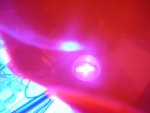- Joined
- Dec 30, 2016
- Messages
- 1,410
- Points
- 0
Math was never my strong suit.... :^)I believe they're definitely in the high 90s for the whole setup, but not quite 99.8% for the complete setup, i.e. both lenses together.
84mW loss at 7W input is 1.2%... Still tiny amounts of loss when you have that much power, but there's some math going wrong somewhere.
The corrected figure is 14mW loss at 7000mW = 99.8% Efficiency or a loss of 0.2% BUT I have no way of verifying that at the moment.....
I reworked my 6X lens pair correction tube and added a "track" system to it that granted isn't the most beautiful thing you've ever laid eyes on BUT I can now "slide" the lenses for adjustments that give me repeatable results.....

Hey what's this switch do ???

Last edited:













